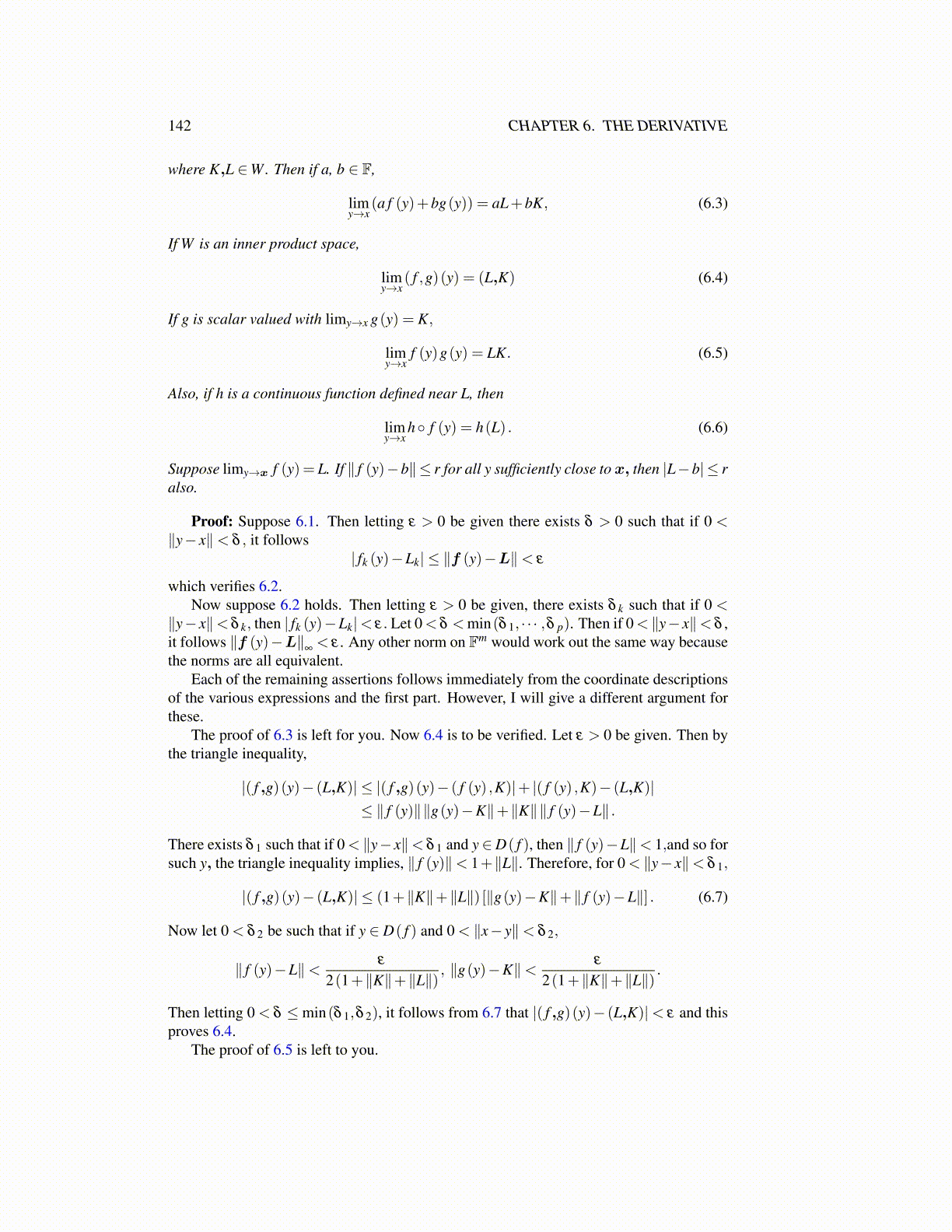
142 CHAPTER 6. THE DERIVATIVE
where K,L ∈W. Then if a, b ∈ F,
limy→x
(a f (y)+bg(y)) = aL+bK, (6.3)
If W is an inner product space,
limy→x
( f ,g)(y) = (L,K) (6.4)
If g is scalar valued with limy→x g(y) = K,
limy→x
f (y)g(y) = LK. (6.5)
Also, if h is a continuous function defined near L, then
limy→x
h◦ f (y) = h(L) . (6.6)
Suppose limy→x f (y) = L. If ∥ f (y)−b∥≤ r for all y sufficiently close to x, then |L−b| ≤ ralso.
Proof: Suppose 6.1. Then letting ε > 0 be given there exists δ > 0 such that if 0 <∥y− x∥< δ , it follows
| fk (y)−Lk| ≤ ∥f (y)−L∥< ε
which verifies 6.2.Now suppose 6.2 holds. Then letting ε > 0 be given, there exists δ k such that if 0 <
∥y− x∥< δ k, then | fk (y)−Lk|< ε. Let 0< δ <min(δ 1, · · · ,δ p). Then if 0< ∥y− x∥< δ ,it follows ∥f (y)−L∥
∞< ε . Any other norm on Fm would work out the same way because
the norms are all equivalent.Each of the remaining assertions follows immediately from the coordinate descriptions
of the various expressions and the first part. However, I will give a different argument forthese.
The proof of 6.3 is left for you. Now 6.4 is to be verified. Let ε > 0 be given. Then bythe triangle inequality,
|( f ,g)(y)− (L,K)| ≤ |( f ,g)(y)− ( f (y) ,K)|+ |( f (y) ,K)− (L,K)|≤ ∥ f (y)∥∥g(y)−K∥+∥K∥∥ f (y)−L∥ .
There exists δ 1 such that if 0 < ∥y− x∥< δ 1 and y∈D( f ), then ∥ f (y)−L∥< 1,and so forsuch y, the triangle inequality implies, ∥ f (y)∥< 1+∥L∥. Therefore, for 0 < ∥y− x∥< δ 1,
|( f ,g)(y)− (L,K)| ≤ (1+∥K∥+∥L∥) [∥g(y)−K∥+∥ f (y)−L∥] . (6.7)
Now let 0 < δ 2 be such that if y ∈ D( f ) and 0 < ∥x− y∥< δ 2,
∥ f (y)−L∥< ε
2(1+∥K∥+∥L∥), ∥g(y)−K∥< ε
2(1+∥K∥+∥L∥).
Then letting 0 < δ ≤min(δ 1,δ 2), it follows from 6.7 that |( f ,g)(y)− (L,K)|< ε and thisproves 6.4.
The proof of 6.5 is left to you.